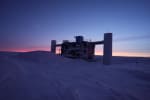The sun is up, but it’s still quite low on the horizon. When you face the sun, as in the image above looking at the South Pole Telescope, all of the surroundings are still dark and in shadow. Face away, as in the image below of the IceCube Upgrade drill camp, and all is clear […]
News
Week 38 at the Pole
Antarctica has sometimes been referred to as the end of the world. But for those who live at the South Pole, there’s a specific place known as the “End of the World.” It’s what they call the area past the storage berms out on the ice. Snow removed from around buildings is often dumped there […]
Week 37 at the Pole
Yes, the sun has officically risen at the Pole. But it happened at the very end of the week, so we may have to wait a bit for an actual sunrise photo (or go back one or two weeks for something close). Last week was busy with several sunrise-related activities. IceCube’s winterovers were out cleaning […]
Week 36 at the Pole
A total lunar eclipse started off last week at the Pole. IceCube winterover Ilya had set up a camera box in advance to capture photos during the event. Unfortunately, the weather was poor and the blood moon was not very visible, plus the outdoor camera setup wasn’t a match for the weather conditions. Still, Ilya […]
Quantifying the estimated sensitivity of the IceCube Upgrade to atmospheric neutrino oscillations
As cosmic rays collide with particles in the Earth’s atmosphere, air showers containing atmospheric muons and neutrinos are produced. The atmospheric neutrinos are then detected by DeepCore, a denser and smaller array of sensors in the center of the IceCube Neutrino Observatory at the South Pole. Compared to the main IceCube detector, DeepCore is sensitive […]
Week 35 at the Pole
As the sky at the South Pole gets brighter, we can definitely see the difference from just two weeks ago in this view of the IceCube Lab. The snow drift is still there, though, and that will stay there until it is intentionally moved—the sun won’t be able to make a dent in it, even […]
Week 34 at the Pole
The sky at the South Pole continues to brighten up before official sunrise—lately to the point where headlamps are no longer needed to see while walking outside. The moon can help brighten things up even more on some days. IceCube winterover Ilya was out with his camera last week, taking some nice photos of the […]
Observation of a spectral change in the flux of astrophysical neutrinos
The IceCube Neutrino Observatory, embedded in a cubic kilometer of Antarctic ice, searches for weakly interacting particles called neutrinos that are able to travel undisturbed through the cosmos. Of interest are high-energy astrophysical neutrinos that can arise from cosmic ray interactions with matter or photons in astrophysical sources. Thus far, the dominant sources of the […]
Week 33 at the Pole
Everything’s blue and rather dark, but not gloomy. There’s just a hint of orange starting to spread along the horizon, brightening up the scenery. Last week at the Pole, IceCube’s winterovers had some minor detector issues to respond to, but they otherwise enjoyed a rather quiet week. That’s the benefit of a well-behaved detector—more quiet […]
Week 32 at the Pole
This could the season’s last view of the IceCube Lab with the Milky Way visible overhead. Key word being could—guess we’ll see. The Milky Way also appears, somewhat more faintly, below as it stretches upward from the IceCube Upgrade drill camp. Last week at the Pole was rather quiet in most respects. The kitchen, however, […]









